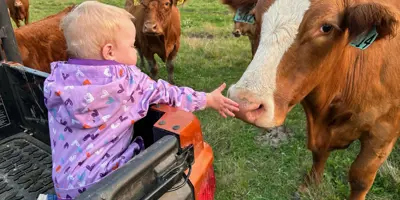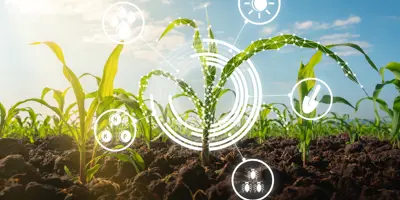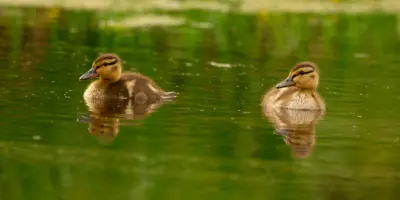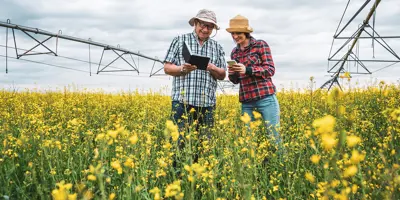The local Partnership Advisory Committee (PAC) oversees the ALUS program. A PAC includes a broad spectrum of community members such as representatives from local environmental groups, government agencies and local industry. Approximately 50 percent of each PAC is made up of farmers.
ALUS Program
ALUS in Saddle Hills County
Saddle Hills County is proud to be an ALUS partner, and is implementing a three-year trial of the program for resident producers.
The ALUS Saddle Hills program coordinator works with local producers to help establish ALUS projects that work to address several important environmental issues. ALUS works to restore difficult to farm, and marginal lands into environmental projects that generate cleaner air and water, wildlife habitat, and other ecosystem services. ALUS enhances wetlands and riparian buffer areas, plants trees to boost wildlife, establishes new pollinator habitats, while also assisting with flood and drought resilience.
ALUS Saddle Hills participants receive professional support and an annual per acre payment for the establishment, maintenance, and long-term environmental outcomes of these ecological projects.
ALUS Vision Statement
Sustaining agriculture, wildlife and natural spaces for communities and future generations.
ALUS Mission Statement
ALUS helps farmers and ranchers build nature-based solutions on their land to sustain agriculture and biodiversity for the benefit of communities and future generations.

Community-Developed
The ALUS program is flexible. It is designed to be customized by local communities to respect local agricultural and environmental priorities, and help create rural resilience.

Farmer-Delivered
Agricultural producers are in a unique position to provide important solutions to some of the most pressing environmental challenges of our time, including climate change and biodiversity loss.

Science-Based
Based on sound scientific principles and verification guidelines, ALUS provides valuable support and technical expertise for the design and implementation of green infrastructure projects and nature-based solutions.

Market-Driven
The ecological services produced by ALUS projects have economic value on the marketplace, which ALUS is actively developing. Citizens, corporations, and philanthropists invest directly in environmental stewardship.

Integrated
The delivery of the ALUS program is intended to complement existing conservation programs, including federal and provincial government policy frameworks.

Targeted
The ALUS program produces ecosystem services on marginal and ecologically sensitive parcels and on lands that can be managed in a different manner.

Accountable
ALUS projects are independently monitored, verified, and audited by trusted farm organizations or reliable institutions. Data collection respects the highest standards in data integrity and confidentiality.

Voluntary
Farmers and ranchers who choose to participate in the ALUS program have flexible agreements that suit their operation and offer them financial compensation for their ecosystem management.
Interested in carrying out an ALUS project on your land? Complete and submit ALUS Expression of Interest and submit it via email to ag@saddlehills.ab.ca, at the County office, or via mail to:
ALUS Program Coordinator
Agricultural Services Department
Saddle Hills County, RR1, Spirit River, AB. T0H 3G0
Frequently Asked Questions
How is ALUS 'Community-Developed' and 'Farmer-Delivered'?
What are Ecosystem Services or Ecological Goods and Services?
These are the services produced by healthy ecosystems that benefit people. In other words: Nature’s Benefits. These services include clean water, clean air, soil fertility, carbon sequestration, erosion control, buffering of climate extremes such as flooding, and healthy fish, wildlife and pollinator habitats.
What are some examples of ALUS projects and the benefits of nature (ecological services)?
- Healthy riparian buffer zones provide critical wildlife habitat and improve water quality.
- Created or restored wetlands, which improve water quality and can protect communities against spring flooding and offset the impact of droughts.
- Restoring native prairie enhances natural grazing, haying options, and critical habitat for species at risk.
- Pollinator hedgerows provide habitat for pollinator’s which in turn pollinate our agricultural crops and native plants.
- Reforestation
Where does funding for ALUS projects come from?
Funding for ALUS comes from a variety of sources including municipal, provincial and federal government, private foundations, private corporations, angler and hunter groups, stewardship councils, agricultural and environmental groups. ALUS has many supporting partners that also generously donate in-kind support.
With the assistance of an ALUS coordinator, farmers submit an Expression of Interest, which provides basic details on their operation. Site visits follow to determine what areas of the farm are best suited for an ALUS project. Participants sign a term agreement. They can opt out at any time, and payments are adjusted accordingly.
What type of land can a farmer enroll?
Most ALUS projects target areas that are marginally productive, are inefficient to farm, or are environmentally sensitive. Examples include saline areas along watercourses, steeply sloped crop land, low wet field areas, and odd areas that are difficult to farm with today’s larger equipment. ALUS also supports alternative management that has environmental benefits such as ensuring appropriate timing and intensity of grazing activities.
How much land can a farmer enroll?
ALUS focuses on environmental outcomes on the working lands. Specifically marginal and ecologically sensitive lands, that are currently under production. In general a maximum of 20 percent of workable land is eligible. Exceptions can be made on a case by case basis.
How much are the annual payments?
Currently payments are based on two factors:
- The average land rental rates in the program area.
- The existing land use (crop land vs. pasture)
How are project ideas developed?
All projects are developed in consultation with the farmer. Project development considers local ecology, project objectives (i.e.: curtailing wind erosion), and the type of farming operation.
Do you monitor and follow up on projects?
All projects are monitored by ALUS program staff, and independently audited by a trusted farm organization or existing institution.
How long is the conservation agreement?
Typically, it’s a three to five year agreement with the possibility of extension pending available funding. Contract length is determined by the local PAC and funding availability.
Yes. The Participant may terminate this Agreement at any time with thirty (30) days prior written notice to the ALUS Entity. If the Participant chooses to terminate this Agreement before the end of the Term, (a) the Annual Payment for the final year of the Term shall be pro-rated to the Notice Date and paid to the Participant; and (b) the Participant shall repay a portion of the establishment costs to the ALUS Entity based on the following formula: establishment costs paid by the ALUS Entity x percentage of Term remaining as of the Notice Date = amount of establishment costs to be repaid by the Participant to the ALUS Entity.
Do you partner with other organizations in the community?
ALUS programs across the country have developed many community partnerships with conservation organizations, agricultural groups and different levels of government.
Does ALUS artificially increase farm incomes?
ALUS is an ecological goods and services delivery program that uses 'fee-for service' to provide environmental benefits to all Canadians. ALUS provides these payments at fair market value, and will not provide environmental subsidies that artificially increase farm incomes.
How does this affect our trade agreements?
ALUS meets international trade obligations, and is similar to programs undertaken by our trading partners to deliver ecosystem services. The program is intended to be production neutral.
Will ALUS provide payments for existing environmental features?
Generally no, but some ALUS communities provide payment for significant improvement of an existing environmental feature. An example would be enhancement of a wetland by riparian fencing to prevent excessive impact from livestock whereby ALUS provides annual payment for existing (and enhanced) wetlands. ALUS may also recognize landscape improvements that have been completed by the participant in the past that are accompanied by new additional environmental restoration, enhancement or creation initiatives. These kinds of decisions are made by local Partnership Advisory Committees.
How do we know the ALUS program is effective?
ALUS recognizes the importance of social, economic and environmental sciences in guiding implementation of the program at all levels. ALUS uses research to optimize the efficiency and effectiveness of program activities as well as monitoring environmental outcomes. As our projects and program matures, ALUS is working with academics across the country to evaluate outcomes of the ALUS program. These studies are long term, but the information is published as it becomes available.
ALUS is unique because the program is community-developed and delivered by farmers. ALUS recognizes the important role farmers and ranchers play as stewards of the land and recognizes the contributions that they make towards keeping our environment healthy through the sharing of project establishment costs and annual payments. ALUS creates a marketplace for farmers to produce and sell ecosystem services.
Yes, ALUS farmers can work with other funding programs as long as they are not 'double dipping'- accessing funding for the same project. ALUS works regularly with other programs to offset initial project establishment costs for the farmer.
Are municipalities on the line for annual payments to farmers if program funding runs out?
No. The year the project is established, the Coordinator takes the full amount for annual payments over the full term out of the budget. Meaning that if a project is established in 2016, and a 5 year agreement is signed, the full cost for the term of the contract is accounted for in the 2016 budget and set aside in trust by the county. That way, the funding is guaranteed to be available should funding amounts fluctuate and if funding were to dry up after the term of the contract, the county isn't on the hook for ongoing payments.
What are advantages of different contract lengths?
The contract length is set by the Partnership Advisory Committee (PAC) of each community so this decision is really up to you. Most communities are using 3 to 5 year terms, and some vary depending on project type and establishment investment. There are, of course, pros and cons to both long and short term agreements. Agreements can be renewed once their term is up.
|
Contract Length |
Pros |
Cons |
|
Short (1-5 yrs) |
· Palatable to farmers who may be nervous about commitment. It makes it easy to agree and enter the program. · Doesn't eat up your funding as fast. |
· Maybe more administrative work if the community/ participant renew the term (the database helps to minimize administrative burden). · Risk the producer will stop their BMPs after the first term and we lose ecosystem service benefits. · If establishment costs are high in the beginning, are we getting enough return on investment from ecosystem services? |
|
Long (+5 yrs) |
· Perception of more conservation value · Maybe less administration for renewals |
· Each project will have a higher cost, so you can do less projects each year (likely balances out in the long term) · Some farmers are hesitant to sign long term agreements, even though the ALUS agreements do have exit clauses. |
More Information:
Contact Us
Saddle Hills
Junction of Hwy 49 & Secondary Hwy 725
RR1, Spirit River AB
T0H 3G0
T. 780-864-3760
Fax 780-864-3904
Toll-free 1-888-864-3760
frontdesk@saddlehills.ab.ca
Sign up to our Newsletter
Stay up to date on the Saddle Hills activities, events, programs and operations by subscribing to our eNewsletters.




